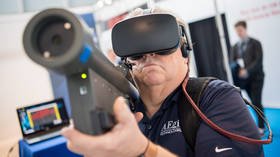Pentagon solicits virtual reality tech to prep soldiers for ‘battlefield nuclear warfare’

The Pentagon has put out a call for virtual reality training environments with “radiological/nuclear considerations” – another sign that the US’ unhealthy obsession with nuclear warfare isn’t going away anytime soon.
The Defense Threat Reduction Agency, a Department of Defense division focused on countering weapons of mass destruction, is looking for virtual reality systems it can use to train combat forces in a “battlefield nuclear warfare environment.” The agency issued a “sources sought notice” last week, seeking technical specs and other market information on “virtual training and testing programs” for combat troops “performing radiological threat objects find and interdict operations” – as well as fighting on the nuclear “battlefield.”
Also on rt.com US ‘not interested in matching new Russian weapons’, but will use nukes if it 'has to'“AR/VR capabilities will not replace field training requirements,” the notice states, adding that its “purpose is to test warfighter scenarios and decision-making to provide users realistic outcomes to support training and course-of-action selection when faced with radiological/nuclear threats.” It may also be used for “planning training scenarios” and “equipment testing events.” While the addition of a realistic VR overlay of post-nuclear devastation could make soldiers more reluctant to push the big red button, that decision has never been left to the rank-and-file, and it’s unlikely their commanders will be lining up to experience even the most high-tech post-apocalyptic training module.
The US military is increasingly relying on training simulators, which carry obvious advantages including cost – avoiding the need to transport troops to the countries they’re training to occupy – and safety. The army awarded two contracts for training simulators last month with the goal of ultimately generating 400 different location-specific training environments. And virtual reality is the only way to provide soldiers with training in a post-nuclear scenario – for now, at least.
Also on rt.com Risk of nuclear war is highest since WW2, perhaps it is time to start paying attentionIt’s the duty of a nation’s military to be prepared, and the Pentagon’s nuclear prepping wouldn’t be nearly so sinister if it hadn’t posted, then removed, a Joint Chiefs of Staff strategy paper last month providing “principles and guidance to plan, execute, and assess nuclear operation.” The chilling document matter-of-factly suggests “using nuclear weapons could create conditions for decisive results and the restoration of strategic stability.” Nor was that an isolated burst of nuclear cheerleading. Last month, Air Force Chief of Staff David Goldfein suggested that the military piggyback its nuclear command and control function on the ever-growing network of commercial satellites.
The US pulled out of the Intermediate-Range Nuclear Forces Treaty earlier this year, immediately embarking on the development of missiles that had been banned under the agreement. When the only military that has ever used nuclear weapons suggests there’s ever an acceptable time and place for their deployment, it’s understandable why the rest of the world might worry.
Like this story? Share it with a friend!













